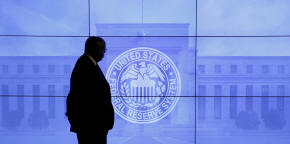Bond market fireworks highlight recession worries
 Send a link to a friend
Send a link to a friend
 [March 22, 2022] By
Davide Barbuscia [March 22, 2022] By
Davide Barbuscia
NEW YORK (Reuters) -Sharp moves in the U.S.
Treasury market are increasingly pointing to the risk of an approaching
recession, with "bond vigilantes coming out of the woodwork" and markets
doubting the U.S. Federal Reserve's plan to engineer a "soft landing"
for the economy as it hikes interest rates to fight inflation, market
experts said.
Fed Chair Jerome Powell said on Monday the U.S. central bank must move
"expeditiously" to bring too-high inflation to heel and that it could
use bigger-than-usual interest rate hikes if needed. Bond yields, which
move inversely to prices, spiked while the U.S. Treasury yield curve
continued its flattening trend.
"The market seems to be challenging the soft-landing view for the U.S.
economy that the Fed argued at the March FOMC meeting", BofA strategists
said.

The U.S. Treasury yield curve reflects "recession risks, and not just
through the curve's extreme flatness at the inception of the Fed
tightening cycle," the strategists said.
The closely followed part of the yield curve measured between 10-year
and two-year Treasuries has narrowed by about 60 basis points since the
start of the year, with the longer-dated notes now yielding less than 20
basis points more than two-year debt.
Any inversion of that part of the curve, when shorter notes yield more
than longer ones, is generally seen as presaging a recession by six to
24 months.
"The yield curve does look ominous," wrote Christopher Murphy, Co-Head
of Derivatives Strategy at Susquehanna Financial Group, although he said
an inversion does not always guarantee a recession.
Melissa Brown, Global Head of Applied Research at Qontigo, said the
yield curve is reflecting a shift in market views on the ability of the
Fed to tighten monetary policy just enough to reduce inflation without
throwing the economy into a recession.
"The market perhaps is assuming that they can't thread that needle ...
it's going to be tough to not drive us into recession", she said.

Still, Powell on Monday said he did not see an elevated likelihood of a
recession in the next year and others are skeptical of such an event.
That prompted Federal funds rate futures on Monday to raise the chances
of a half percentage-point tightening at the next policy meeting in May.
Analysts at NatWest said Powell was clearly "warning of risks to 50bp
hike(s) at the coming meetings," which they said sent Treasuries into
"free fall."
When asked on Monday about concerns on what the yield curve is saying,
Powell said that he focused on the short end of the curve, meaning the
first 18 months of maturities.
[to top of second column] |

A security guard walks in front of an image of the Federal Reserve
following the two-day Federal Open Market Committee (FOMC) policy
meeting in Washington, March 16, 2016. REUTERS/Kevin Lamarque

Morgan Stanley said in a research note on Sunday that an inversion of the yield
curve was possible in the second quarter this year, but that an inversion does
not necessarily anticipate a recession.
"However, it does support our view for sharply decelerating earnings growth", it
said.
For Tim Holland, chief investment adviser at Orion Advisor Solutions, a
recession is not imminent, despite the flat curve.
Another part of the curve which compares three-month bills with 10-year notes
has steepened this year, from 145 basis points on Dec. 31 to 181.54 basis points
on Monday.
"If the past 30 years is any guide, both parts of the curve need to flatten and
invert before we are at risk of recession", he said.
Powell's speech on Monday at a National Association for Business Economics
conference caught some market participants off guard as they seemed more hawkish
than his remarks after the Fed last Wednesday raised the federal funds rate by
25 basis points.
Yields spiked on Monday with the 10-year benchmark note up to a yield of 2.298%
from 2.153% on Friday - the highest since May 2019. Yields of two-year
Treasuries, which more closely reflect monetary policy expectations, jumped to
2.111% from 1.942% on Friday.
"What you saw today is Powell basically throwing the towel, he said he's going
to do whatever it takes, and it took the market a little bit back", said Andrew
Brenner, head of international fixed income at National Alliance Securities.

Brenner described the bond market behaviour as that of bond vigilantes - when
investors insist on high yields to compensate for the risk of inflation.
"Bond vigilantes have come out of the woodwork," Brenner said, adding he saw a
large amount of selling in the futures market, particularly concentrated in
five-year futures.
(Reporting by Davide Barbuscia; additional reporting by Alden Bentley; Editing
by Megan Davies, Hugh Lawson and Bernard Orr)
[© 2022 Thomson Reuters. All rights
reserved.]This material may not be published,
broadcast, rewritten or redistributed.
Thompson Reuters is solely responsible for this content.
 |